基于Socket技术的企业局域网通信软件设计与实现毕业设计
宋奇基于Winsocket局域网通讯软件的设计与实现

宋奇基于Winsocket局域网通讯软件的设计与实现————————————————————————————————作者:————————————————————————————————日期:辽东学院本科毕业论文(设计)基于Winsocket局域网通讯软件的设计与实现The Design and Implementation for LAN Communication SoftwareBased on WinSocket学生姓名:宋奇学院:信息技术学院专业:网络工程班级:B0904学号:0913090423指导教师: 厉鹏审阅教师:完成日期:2013.5.23辽东学院Eastern Liaoning University独创性说明作者郑重声明:本毕业论文(设计)是我个人在指导教师指导下进行的研究工作及取得研究成果。
尽我所知,除了文中特别加以标注和致谢的地方外,毕业论文(设计)中不包含其他人已经发表或撰写的研究成果,也不包含为获得辽东学院或其他单位的学位或证书所使用过的材料.与我一同工作的同志对本研究所做的贡献均已在论文中做了明确的说明并表示了谢意。
作者签名:___________ 日期:__ __摘要随着网络技术的不断发展,网络通讯在如今已经不算新鲜事物,但是大多数网络通讯都需要借助Internet来实现,但是Internet技术给那些大规模内部网络的用户带来了一系列问题,比如遭遇到网络恶意攻击、网络病毒的传播、破坏防御系统等等。
因为互联网上的通讯工具给企业内部以及学校局域网信息交流带来了不便比较多,所以为了方便局域网内的用户之间的交流,需要开发一个基于局域网的通讯通讯,实现在内部网络中进行信息的交流。
本课题设计主要针对局域网通讯而开发设计的,采用的是C/S构架,利用Delphi编程工具来实现单播、广播以及在线用户显示和查看历史记录的功能,并借助一些网络通讯组件,成功的实现了在局域网上的即时通讯。
基于SOCKET技术的网络即时通讯软件的设计与实现

目录摘要 (1)1 前言 (1)2 可行性研究 (2)2.1开发背景 (2)2.2技术可行性分析 (2)2.3面临问题及现状 (2)2.4开发目的及意义 (3)2.5.1运行环境 (3)2.5.2性能要求 (3)3 需求分析 (3)3.1系统总体功能 (3)3.2开发工具以及使用的主要技术简介 (4)3.2.1数据库Microsoft SQL2000简介 (5)3.2.2 eclipse简介 (6)3.3客户机/服务期(C/S)工作原理 (7)3.4套接字(SOCKET)原理图 (8)3.5系统逻辑模式 (8)3 概要设计 (9)3.1客户端 (10)3.1.1 用户注册功能模块 (10)3.1.2发送消息功能模块 (11)3.1.3查找好友功能模块 (11)3.1.4 添加好友模块 (11)3.1.5删除好友模块 (12)3.1.6修改个人信息模块 (12)3.2服务器 (12)3.2.1用户登录模块设计 (13)3.2.2新用户注册模块设计 (14)3.2.3查找网友模块设计 (15)3.2.4添加好友模块设计 (16)3.2.5 用户之间发送数据模块设计 (17)3.3数据库设计 (18)3.3.1数据库结构设计 (19)3.3.2数据表设计 (19)3.3.3 数据字典 (21)(1) 聊天信息字典 (21)4 详细设计 (22)4.1服务器端 (22)4.1.1服务器建立和启动模块 (22)4.1.2 数据库交互模块 (23)4.1.3 处理客户端请求模块 (25)4.1.4 异常处理模块 (25)4.2客户端 (25)4.2.1 客户端与服务器建立连接模块 (25)4.2.2 用户登陆模块 (26)4.2.3 注册模块 (26)4.2.4 通讯模块 (27)4.2.5 聊天模块 (28)4.2.6 查找好友模块 (29)4.2.7个人信息模块 (30)5 总结 (32)参考文献 (33)致谢........................................... 错误!未定义书签。
基于socket简易聊天程序毕业设计(论文)

简单的socket程序虽然很简单,但还是调试了很长时间。
本科时候接触过socket——那个帅帅的刘老师的课,现在重新再捡起来。
程序中专门建立一个FunThread线程用来接收数据,实现双向通信,也可以连续发送、连续接收。
代码贴上来,如果还能保留VA View那样的颜色区别就好看了,但是试了好几遍都不行server:#include <WINSOCK2.H>#include <stdio.h>#define PORT 6000 //服务器端口#define MSGSIZE 1024 //收发缓冲区的大小#pragma comment(lib, "ws2_32.lib") //链接静态库DWORD WINAPI FunThread(LPVOID); //创建一个线程,专门用来接收数据SOCKET sClient; //连接所用套节字SOCKET sListen; //监听套接字SOCKADDR_IN client; //保存客户的地址信息int iaddrSize = sizeof(SOCKADDR_IN);int main(){WSADATA wsaData;SOCKADDR_IN local;char s_Message[MSGSIZE]; //收发缓冲区WSAStartup(0x0202, &wsaData); //Initialize Windows socket librarysListen = socket(AF_INET, SOCK_STREAM, IPPROTO_TCP);//创建服务器监听套节字。
TCP协议local.sin_family = AF_INET; //AF_INET指明使用TCP/IP协议族local.sin_port = htons(PORT);//指明连接服务器的端口号local.sin_addr.s_addr = htonl(INADDR_ANY);//自动获取本机地址bind(sListen, (struct sockaddr *)&local, sizeof(SOCKADDR_IN));//地址绑定到套接字listen(sListen, 1);//开始监听sClient = accept(sListen, (struct sockaddr *)&client, &iaddrSize);//建立连接printf("Accepte client:%s:%d\n", inet_ntoa(client.sin_addr),ntohs(client.sin_port));HANDLE hThread=CreateThread(NULL,0,FunThread,0,0,0);//创建接收线程CloseHandle(hThread);while (TRUE){printf("Server Send:");//从键盘输入gets(s_Message);//发送数据send(sClient, s_Message, strlen(s_Message), 0);}return 0;}DWORD WINAPI FunThread(LPVOID){char c_Message[MSGSIZE]; //收发缓冲区int ret; //接收字节的个数while (TRUE){ret = recv(sClient, c_Message, MSGSIZE, 0);//接收数据if(ret==SOCKET_ERROR){printf("\nclient is closed!");sClient = accept(sListen, (struct sockaddr *)&client,&iaddrSize);//重新开始监听printf("\nAccepte new client:%s:%d",inet_ntoa(client.sin_addr), ntohs(client.sin_port));memset(c_Message,0,1024);//将原来的client message归零continue;}c_Message[ret] = '\0';printf("\nReceived: %s\n", c_Message);}return 0;}client:#include <WINSOCK2.H>#include <stdio.h>#define SERVER_ADDRESS "127.0.0.1" //服务器端IP地址#define PORT 6000#define MSGSIZE 1024#pragma comment(lib, "ws2_32.lib")DWORD WINAPI FunThread(LPVOID);SOCKET sClient;SOCKADDR_IN server;int main(){WSADATA wsaData;char c_Message[MSGSIZE];WSAStartup(0x0202, &wsaData);sClient = socket(AF_INET, SOCK_STREAM, IPPROTO_TCP);memset(&server, 0,sizeof(SOCKADDR_IN)); //先将保存地址的server置为全0server.sin_family =PF_INET; //声明地址格式是TCP/IP地址格式server.sin_port =htons(PORT); //指明连接服务器的端口号server.sin_addr.s_addr = inet_addr(SERVER_ADDRESS); //指明连接服务器的IP地址connect(sClient, (struct sockaddr *)&server, sizeof(SOCKADDR_IN)); //连到刚才指明的服务器上HANDLE hThread=CreateThread(NULL,0,FunThread,0,0,0);CloseHandle(hThread);while (TRUE){printf("Client Send:");gets(c_Message);send(sClient, c_Message, strlen(c_Message), 0);if(!strcmp(c_Message,"exit"))//client自身退出exit(1);}// 释放连接和进行结束工作closesocket(sClient);WSACleanup();return 0;}DWORD WINAPI FunThread(LPVOID){char s_Message[MSGSIZE];int ret;while (TRUE){ret = recv(sClient, s_Message, MSGSIZE, 0);if(ret==SOCKET_ERROR){printf("\nServer is closed!\n");exit(1);}s_Message[ret] = '\0';printf("\nReceived: %s\n", s_Message);if(!strcmp(s_Message,"exit"))//server让client退出exit(1);}return 0;}程序在VC++ 6.0环境下编译通过。
“基于Socket的网络聊天系统的设计与实现”课程设计报告

《计算机网络课程设计报告》学院:计算机科学学院专业:计算机科学与技术班级:08级01班姓名:学号:小组成员:ABCDEF2011-7-13项目内容:基于Socket的网络聊天系统的设计与实现实验目的:基于Socket套接口,实现网络聊天系统的设计与实现,让我们掌握Socket的编程技术及网络服务的技术,让同学们更加深刻的了解,并掌握这方面的知识。
实验环境:操作系统:windows2000或windows2003;内存:256M以上;基于eclipse的JAVA运行环境。
设计方案:首先,我们知道此应用软件需实现网络中多台主机的信息互通,实现语言文字得互聊,因此涉及到主机网络互联的问题,所以必须会应用到网络协议,可以用UDP或TCP。
其次,既然要求设计基于Socket的网络聊天系统,那就必须对Socket有一个充分的了解。
最后,不管运用何种语言设计此程序,都要求对该语言有一个透彻的了解,并能运用自如。
实现流程:启动电脑,打开能运行该程序的环境,必须保证代码的正确性;进行窗体框架的设计,实现网络连接,并达到网络聊天的功能;在以上步骤的成功进行下达到设计要求的基于S o c k e t s的局域网内聊天系统的函数实现的目的。
结果及分析:程序运行以后,经过局域网内测试,实现了在局域网内的好友添加,聊天等功能,基本上完成了本实验的全部要求。
但由于时间仓促,再加上本人水平有限,对这方面的知识还有所欠缺,经过这次课程设计,对此有了一个很大的提高。
源程序;一 Client端程序代码package wangluo;import java.awt.BorderLayout;import java.awt.event.ActionEvent;import java.awt.event.ActionListener;import java.io.DataInputStream;import java.io.DataOutputStream;import javax.swing.JFrame;import javax.swing.JTextField;public class Client implements ActionListener {private JTextField jtf = new JTextField("", 20);JFrame jf = new JFrame("不用注册直接登陆");public Client() {jf.setLayout(new BorderLayout());jf.add(jtf, BorderLayout.NORTH);jtf.addActionListener(this);jf.pack();jf.setLocation(500, 300);jf.setResizable(false);jf.setVisible(true);jf.setDefaultCloseOperation(JFrame.EXIT_ON_CLOSE);}@Overridepublic void actionPerformed(ActionEvent e) {jf.dispose();new ThreadClient(jtf.getText());}public static void main(String[] args) {new Client();}}二ThreadClient端程序代码:package wangluo;import java.awt.BorderLayout;import java.awt.GridLayout;import java.awt.event.ActionEvent;import java.awt.event.ActionListener;import java.awt.event.WindowAdapter;import java.awt.event.WindowEvent;import java.io.DataInputStream;import java.io.DataOutputStream;import .Socket;import javax.swing.JButton;import javax.swing.JFrame;import javax.swing.JPanel;import javax.swing.JTextArea;import javax.swing.JTextField;public class ThreadClient extends Thread implements ActionListener { private String name = "";private int a;private JTextField jtf = new JTextField("", 25);private JTextArea jta = new JTextArea(30, 40);private DataOutputStream dos;private DataInputStream dis;private Socket s;public ThreadClient(String temp) {=temp;JFrame jf = new JFrame("聊天界面");jf.setLayout(new BorderLayout());JButton jb = new JButton("发送");JPanel jp = new JPanel();jta.setLayout(new GridLayout(1, 2));jp.add(jtf);jp.add(jb);jf.add(jp, BorderLayout.NORTH);jf.add(jta);jb.addActionListener(this);jtf.addActionListener(this);jf.pack();jf.setLocation(450, 200);jf.setVisible(true);jf.setSize(400, 350);try {s = new Socket("127.0.0.1", 1024);dos = new DataOutputStream(s.getOutputStream());dis=new DataInputStream(s.getInputStream());dos.writeUTF("<1.1>");dos.writeUTF(name);System.out.println("heh");} catch (Exception e) {e.printStackTrace();}jf.addWindowListener(new WindowAdapter() {@Overridepublic void windowClosing(WindowEvent e) {try {dos.writeUTF("<1.4>");Thread.sleep(2000);dis.close();dos.close();s.close();} catch (Exception e1) {e1.printStackTrace();}System.exit(1);}});this.start();}@Overridepublic void run() {while(true){try {Thread.sleep(3000);dos.writeUTF("<1.3>");jta.setText(dis.readUTF());} catch (Exception e) {break;}}}@Overridepublic void actionPerformed(ActionEvent ae) { String comn=jtf.getText();if(!"".equals(comn)){try {dos.writeUTF("<1.2>");dos.writeUTF(comn);jtf.setText("");jtf.requestFocus();} catch (Exception e) {e.printStackTrace();}}}}三ThreadServer端程序代码:package wangluo;import java.io.DataInputStream;import java.io.DataOutputStream;import java.io.IOException;import .ServerSocket;import .Socket;public class ThreadServer extends Thread {//private StringBuffer message = new StringBuffer();private static String message="";private Socket s;private String name="";public ThreadServer(Socket s) {this.s = s;}public void run() {try {DataOutputStreamdos=new DataOutputStream(s.getOutputStream());DataInputStream dis=new DataInputStream(s.getInputStream());while (true) {String temp=dis.readUTF();if("<1.1>".equals(temp)){name=dis.readUTF();message="欢迎"+name+"进入!"+"\n"+message;}else if("<1.2>".equals(temp)){message=name+"说:"+dis.readUTF()+"\n"+message;}else if("<1.3>".equals(temp)){dos.writeUTF(message);}else if("<1.4>".equals(temp)){message=name+"离开"+"\n"+message;break;}}dos.close();dis.close();} catch (Exception e) {e.printStackTrace();}}public static void main(String[] args) throws Exception { ServerSocket ss = new ServerSocket(1024);while (true) {Socket s = ss.accept();new ThreadServer(s).start();}}}安装演示说明详细步骤:首先将自己所在电脑作为服务器端,在JAVA环境下运行该程序,出现以下页面:再在光标所示位置输入用户名称,或直接按回车键进入聊天界面:再将其他主机作为客户端,与服务器所在的主机进行连接,成功后界面如下:在输入框中输入要发送的信息,点击发送如上所示,本实验演示完毕。
基于socket通信系统设计
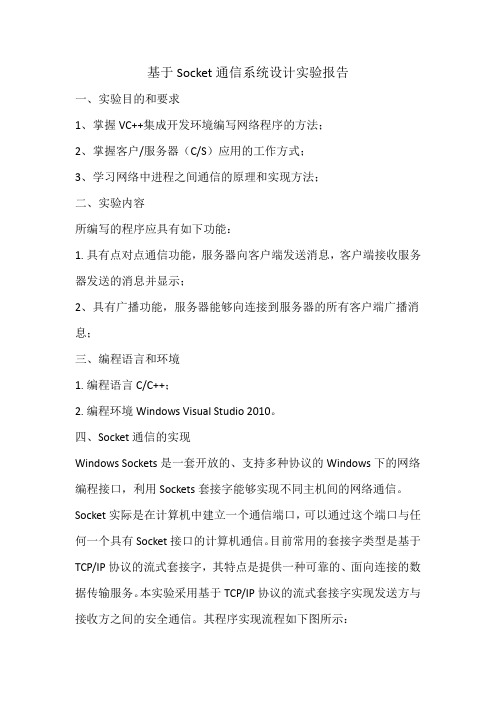
基于Socket通信系统设计实验报告一、实验目的和要求1、掌握VC++集成开发环境编写网络程序的方法;2、掌握客户/服务器(C/S)应用的工作方式;3、学习网络中进程之间通信的原理和实现方法;二、实验内容所编写的程序应具有如下功能:1. 具有点对点通信功能,服务器向客户端发送消息,客户端接收服务器发送的消息并显示;2、具有广播功能,服务器能够向连接到服务器的所有客户端广播消息;三、编程语言和环境1. 编程语言C/C++;2. 编程环境Windows Visual Studio 2010。
四、Socket通信的实现Windows Sockets是一套开放的、支持多种协议的Windows下的网络编程接口,利用Sockets套接字能够实现不同主机间的网络通信。
Socket实际是在计算机中建立一个通信端口,可以通过这个端口与任何一个具有Socket接口的计算机通信。
目前常用的套接字类型是基于TCP/IP协议的流式套接字,其特点是提供一种可靠的、面向连接的数据传输服务。
本实验采用基于TCP/IP协议的流式套接字实现发送方与接收方之间的安全通信。
其程序实现流程如下图所示:服务器端客户端1.服务器端首先调用socket函数来建立一个套接字;套接字创建成功后,调用bind函数将一个IP地址和端口号绑定到己经建立的socket上;绑定完成之后,服务器等待接收客户端的连接请求,调用listen函数实现监听的功能;监听到连接请求之后,服务器调用accept函数生成一个新的套接口描述符,以接受客户的连接请求,之后调用send/receive 函数在套接字上进行数据的读/写,直至完成交换;通信结束之后,调用close函数关闭套接字。
服务器socket通信程序://创建socket套接字连接if(m_hSocket != NULL){closesocket(m_hSocket);m_hSocket = NULL; }if(m_hSocket == NULL){m_hSocket = socket(AF_INET, SOCK_STREAM,0);ASSERT(m_hSocket != NULL); }m_addr.sin_family = AF_INET;m_addr.sin_addr.S_un.S_addr = INADDR_ANY;m_addr.sin_port = htons(m_nPort);int ret = 0,error = 0;ret = bind(m_hSocket, (LPSOCKADDR)&m_addr, sizeof(m_addr));if(ret == SOCKET_ERROR){TRACE("Bind Error: %d \n", (error = WSAGetLastError()));return ; }ret = listen(m_hSocket, 2);if(ret == SOCKET_ERROR){TRACE("Listen Error: %d \n", (error = WSAGetLastError()));return ; }SOCKET s = accept(m_hSocket, NULL, NULL);if(s == SOCKET_ERROR){TRACE("Accept Error: %d \n", (error = WSAGetLastError()));return ; }//监听接收到信息char buff[256];ret = recv(s, buff, 256, 0);if(ret == 0 || ret == SOCKET_ERROR ){TRACE("Recv data error: %d\n", WSAGetLastError());return ; }char* name = NULL;char* pass = NULL;int len = 0;len = buff[0];name = new char[len + 1];for(int i = 0; i < len; i++)name[i] = buff[i+1];int len2 = buff[len + 1];pass = new char[len2 + 1];for(int i = 0; i < len2; i++)pass[i] = buff[i + 2 + len];//发送消息代码CString str;if(strcmp(name, "ware") != 0){str = _T("用户名不正确!");TRACE(_T("用户名不正确!\n")); }else{if(strcmp(pass, "11111") != 0){str = _T("用户密码不正确!");TRACE(_T("用户密码不正确!\n")); } }if(str.IsEmpty()){ str =_T("我是马琰");str +=SendMsg; }char* buf = str.GetBuffer(0);ret = send(s, buf, str.GetLength(), 0);if(ret != str.GetLength()){TRACE("Send data error: %d\n", WSAGetLastError());return ; }2.客户端首先调用socket函数来建立一个套接字;成功创建套接字之后,再调用bind函数,将一个端口绑定到已经建立的socket上;之后客户端便可调用connect函数向服务器请求连接;通信连接建立之后,客户端则可通过调用send/receive函数完成数据交换;通信结束之后,关闭套接字。
基于socket的即时通讯软毕业设计(论文) 推荐
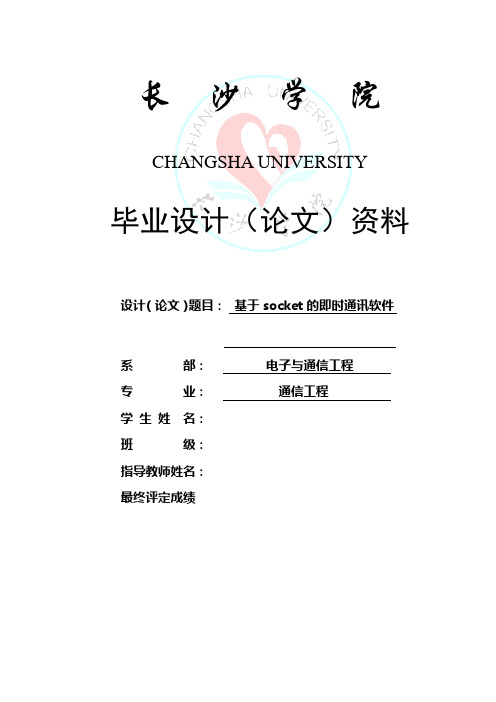
长沙学院CHANGSHA UNIVERSITY毕业设计(论文)资料目录第一部分毕业论文一、毕业论文第二部分外文资料翻译一、外文资料原文二、外文资料翻译第三部分过程管理资料一、毕业设计(论文)课题任务书二、本科毕业设计(论文)开题报告三、本科毕业设计(论文)中期报告四、毕业设计(论文)指导教师评阅表五、毕业设计(论文)评阅教师评阅表六、毕业设计(论文)答辩评审表2009届本科生毕业设计(论文)资料第一部分毕业论文(2009届)本科生毕业论文基于socket的即时通讯软件2009年 6 月长沙学院本科生毕业论文基于socket的即时通讯软件系(部):电子与通信工程专业:通信工程学号: 2005043201学生姓名:闫成超指导教师:张明高级工程师2009 年6 月摘要近些年来,随着计算机技术的飞快发展,尤其是计算机网络方面的发展,人们的生活得到了彻彻底底的改变,人们能以非常低廉的价格,甚至不用花钱,就可以用上更方便、更实用的网络通信软件。
现在,网络上的在线服务系统多种多样,它们已经深深的影响并改变了人们的联系和交流方式,使得人们可以在千里之遥进行即时性的通讯。
过去的种种陈旧的通讯方式,已经不能满足现代生活的需要。
即时通讯软件作为一种方便人与人之间联系的实用工具应运而生,为我们的学习和工作,带来了极大的方便,很大程度的提高了学习和工作效率。
由于即时通讯软件的外观友好、使用非常方便,而且使用者之间的通讯是即时互动的特点,受到大多数人的喜欢,这一类通讯软件的应用市场特别广阔。
现如今,很多的企业、机关、学校都纷纷建立起自己的局域网。
于是我就想到做一个在局域网里的多功能通讯软件,在局域网里,我们可以通过它,实现在局域网里联络,消息的发布等。
在学校建立的校园网里,这软件可以方便同学之间、教师之间、师生之间即时性的联络,这样,不用上Internet,可以节省资源。
在学校这个大环境里,这个软件可以方便同学之间联系,促进同学之间的友谊,学生可以通过它来与不同寝室的同学,与教师讨论问题,并能最大限度地利用现有的网络资源,极大地提高工作效率。
毕业论文局域网聊天软件的设计与实现原理

摘要在网络越来越发达的今天,人们对网络的依赖越来越多,越来越离不开网络,由此而产生的聊天工具越来越多,例如,国外的ICQ、国内腾讯公司开发的OICQ。
基于Java网络编程的强大功能,本次毕业设计使用Java编写一个聊天系统。
一般来说,聊天工具大多数由客户端程序和服务器程序外加服务器端用于存放客户数据的数据库组成,本系统采用客户机/服务器架构模式通过Java提供的Socket类来连接客户机和服务器并使客户机和服务器之间相互通信,由于聊天是多点对多点的而Java提供的多线程功能用多线程可完成多点对多点的聊天,数据库管理系统用SQL Server2000完成并通过JDBC-ODBC桥访问数据库。
本系统建立在JAVA平台上,系统的设计使用了面向对象技术和面向对象的设计原则。
系统采用C/S结构,客户端与客户端以及客户端与服务器端之间通过Socket传送消息。
使用JAVA语言编写,开发工具采用Eclipse。
服务器端设计与实现过程中,采用了多线程技术,可以在单个程序当中同时运行多个不同的线程,执行不同的任务。
大大增强了程序对服务器资源的利用。
聊天系统完成后将可进行多人对多人的聊天,对好友进行添加、删除,对新用户的注册,发送消息、接受消息等等功能。
关键字:多线程;客户机/服务器;JAVA ; Socket ; Eclipse ; TCP/IPAbstractas the network become more and more developed, people become more and more lean to the network, and can not leave with out it. This caused the chat materials become more numerous, as the overseas ICQ system, the OICQ system that invented by Tencent Co., and so on. So we create a network chat medium just like the QQ.Java network programming based on the power, the use of Java designed to prepare graduates a chat system.In general, the majority of the chat tool for client and server program in addition to server-side storage of customer data for the database,the system uses a client / server architecture model the adoption of Java provided Socket class connect client and server and between the client and server communicate with each other, as the chat is to provide point-to-multipoint and multi-threaded Java function to be completed by using multi-threaded chat and more point-to-multipoint, database management system with SQL Server2000 the completion and adoption of JDBC-ODBC Bridge access the database.The system built on the JAVA platform, the system design using object-oriented technology and object-oriented design principles. System uses the C / S structure, client and client-side and server-side client and send messages through Socket. The use of JAVA language, development tools using Eclipse. Design and Implementation of server-side process, the use of multi-threading technology, which can process in a single run at the same time a number of different threads, the implementation of different tasks. Procedures greatly enhanced the use of server resources.Chat system will allow people to complete chat to more friends,and the system can add, delete somebody,can deal with new user registration, send messages, receive messages and so on.Keywords : Multithreading ;Client/Server ;JAVA ;Socket ;Eclipse ;TCP/IP目录1 绪论 (5)1.1国内外聊天系统的研究现状 (5)1.2J AVA语言 (6)1.2.1 Java的发展历史 (6)1.2.2 Java的特点 (7)1.2.3 Java与Internet (7)1.3S OCKET编程 (8)1.3.1 关于TCP/IP协议 (8)1.3.2 服务器和客户机 (9)1.4本文内容安排 (9)2 需求分析 (10)2.1可行性研究 (10)2.1.1 可行性分析 (10)2.1.2系统功能需求 (10)2.1.3 系统性能需求 (11)2.1.4 系统运行需求 (11)2.2数据流图 (11)2.2.1 顶层数据流图 (11)2.2.2 一层数据流图 (12)2.2.3 二层数据流图 (13)3 概要设计 (14)3.1系统实现原理 (14)3.2系统实现层次图: (15)3.3各模块详细功能 (15)3.3.1服务器端结构 (15)3.3.2 客户端结构 (16)4 详细设计 (17)4.1系统流程图 (17)4.1.1 系统总体流程图 (17)4.1.2 系统客户端流程图 (18)4.2编写服务器端程序 (18)4.2.1 问题陈述 (18)4.2.2 解决方案 (19)4.3客户端程序编写 (23)4.3.1 (23)4.3.2 用户登录 (23)4.3.3 聊天室 (24)参考文献 (30)致谢 (31)1 绪论1.1国内外聊天系统的研究现状目前国内外做聊天系统的公司很多,产品也琳琅满目,国内有诸如腾讯QQ、新浪UC、网易泡泡等,国外有著名的MSN(新版改名为Live Messenger)以及跨平台Gaim等。
基于Socket的局域网通信工具的设计与实现的方法
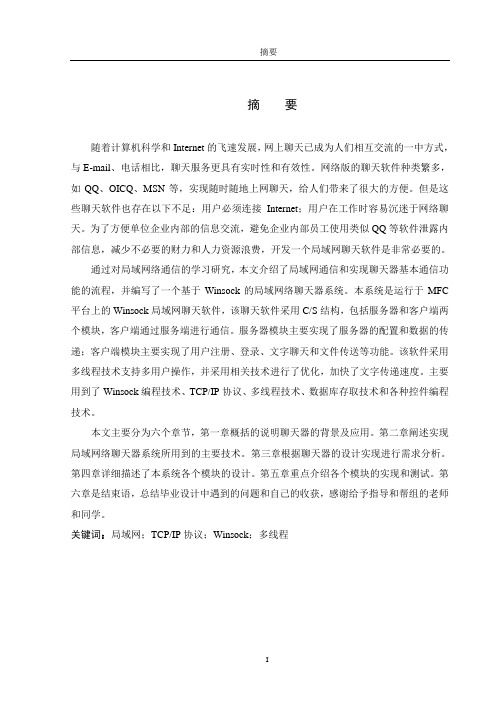
摘要摘要随着计算机科学和Internet的飞速发展,网上聊天已成为人们相互交流的一中方式,与E-mail、电话相比,聊天服务更具有实时性和有效性。
网络版的聊天软件种类繁多,如QQ、OICQ、MSN等,实现随时随地上网聊天,给人们带来了很大的方便。
但是这些聊天软件也存在以下不足:用户必须连接Internet;用户在工作时容易沉迷于网络聊天。
为了方便单位企业内部的信息交流,避免企业内部员工使用类似QQ等软件泄露内部信息,减少不必要的财力和人力资源浪费,开发一个局域网聊天软件是非常必要的。
通过对局域网络通信的学习研究,本文介绍了局域网通信和实现聊天器基本通信功能的流程,并编写了一个基于Winsock的局域网络聊天器系统。
本系统是运行于MFC 平台上的Winsock局域网聊天软件,该聊天软件采用C/S结构,包括服务器和客户端两个模块,客户端通过服务端进行通信。
服务器模块主要实现了服务器的配置和数据的传递;客户端模块主要实现了用户注册、登录、文字聊天和文件传送等功能。
该软件采用多线程技术支持多用户操作,并采用相关技术进行了优化,加快了文字传递速度。
主要用到了Winsock编程技术、TCP/IP协议、多线程技术、数据库存取技术和各种控件编程技术。
本文主要分为六个章节,第一章概括的说明聊天器的背景及应用。
第二章阐述实现局域网络聊天器系统所用到的主要技术。
第三章根据聊天器的设计实现进行需求分析。
第四章详细描述了本系统各个模块的设计。
第五章重点介绍各个模块的实现和测试。
第六章是结束语,总结毕业设计中遇到的问题和自己的收获,感谢给予指导和帮组的老师和同学。
关键词:局域网;TCP/IP协议;Winsock;多线程AbstractWith the computer science and the rapid development of Internet, online chat has become a way of mutual exchange of one, and E-mail, phone calls with real-time chat services and more effective. Online chat software, a wide variety, such as QQ, OICQ, MSN and so on, to achieve anytime, anywhere access to chat, to bring a great convenience. But the lack of chat software, there are the following: the user must be connected to Internet; users to work easily addicted to online chat. To facilitate the exchange of information within business units to avoid the use of internal staff and other software like QQ leaked internal information to reduce unnecessary waste of financial and human resources to develop a LAN chat software is very necessary.Through the study of local area network communication, this article describes the communication and implementation of local area network chat basic communication process device, and write a Winsock-based local area network chat control system. The system is running on the platform at the MFC Winsock LAN chat software, chat software with the C / S structure, including both server and client modules, the client side to communicate through the service. Server module main achievement of the server's configuration and data transfer; client module main achievement of the user registration, login, text chat and other functions. The software supports multi-threading multi-user operation, and optimized use of relevant technologies, accelerate the transmission speed of text. Mainly used the Winsock programming, TCP / IP protocol, multi-threading, database access technology, and various control programming.This paper is divided into six chapters, the first chapter general description of the background of chat devices and applications. The second chapter to achieve local area network chat system used in the main control technology. Chapter III device under the design and implementation needs analysis chat. The fourth chapter describes in detail the design of the various modules of the system. Chapter V focuses on the implementation andtesting of each module. Chapter VI is the Conclusion, summarizes the problems encountered in the design school and their own harvest for guidance and help teachers and students groups.Key words: LAN;TCP / IP protocol;Winsock;multi-threaded目录摘要 (I)Abstract (II)1绪论 (1)1.1背景知识 (1)1.2国内外聊天器系统研究现状 (1)1.3选题的目的及意义 (3)1.4本课题研究内容 (3)1.5本章小结 (4)2 实现原理及开发环境 (5)2.1M ICROSOFT O FFICE A CCESS (5)2.2套接字(S OCKET) (6)2.2.1 Windows Socket介绍(Winsock) (8)2.2.2 Socket的同步和异步方式 (9)2.2.3 用Socket 开发一个Server-Client模型的程序 (10)2.3多线程技术 (11)2.4TCP/IP协议、UDP协议 (12)2.4.1 面向连接的TCP (13)2.4.2 面向非连接的UDP协议 (14)2.5C LIENT/S ERVER结构(客户机/服务器模式) (15)2.6编程环境 (17)2.6.1 硬件环境 (17)2.6.2 软件环境 (17)2.6.3 开发工具介绍 (17)2.7本章小结 (18)3 需求分析 (19)3.1需求分析 (20)3.1.1 可行性分析 (20)3.2.2 系统性能需求 (20)3.1.3 系统运行需求 (21)3.2数据流图 (21)3.2.2 一层数据流图 (21)3.2.3 二层数据流图 (22)3.3本章小结 (21)4 系统设计 (23)4.1系统实现原理 (23)4.2C/S架构设计 (24)4.3模块设计 (26)4.3.1 系统流程图 (26)4.3.1.1 系统总体流程图 (26)4.3.1.2系统客户端流程图 (27)4.3.2 数据库设计 (27)4.4界面效果 (28)4.5本章小结 (29)5 系统实现及测试 (30)5.1服务端 (30)5.1.1 自动配置数据源 (30)5.1.2 定义服务端的关键结构体 (31)5.1.2.1 用户信息的结构体 (31)5.1.2.2 在线用户结构体 (31)5.1.2.3 Socket信息结构体 (32)5.1.3 启动winsocket2 (32)5.1.4 调用两个WINAPI函数 (33)5.1.4.1 接收 client 连接的WINAPI 函数 (33)5.1.4.2 线程操作处理 WINAPI 函数 (36)5.1.5 模块功能实现(代码略) (39)5.1.6 模块界面 (39)5.2客户端 (40)5.2.1 登录模块 (40)5.2.2 注册模块 (42)5.2.3 文字聊天模块 (44)5.2.3.1 发送消息: (44)5.2.3.2 连接信息服务器 (45)5.2.4 文件传送 (48)5.2.4.1 发送文件 (48)5.2.4.2 接收文件 (50)5.3系统测试 (51)5.3.1 测试环境 (52)5.3.2 测试原则 (52)5.3.3 测试方法及结果 (52)5.4本章小结 (56)结论 (57)致谢 (58)参考文献 (59)1绪论1.1 背景知识近年来,随着全球信息化进程的不断发展,网络也在飞速发展。
基于C-S模式的局域网络聊天软件系统的设计与实现

基于C-S模式的局域网络聊天软件系统的设计与实现基于C/S模式的局域网络聊天软件系统的设计与实现一、引言随着科技的不断发展,互联网已经渗透到了我们工作和生活的方方面面。
在日常生活中,人们经常需要与朋友、家人、同事等进行实时交流。
为了满足人们对实时交流的需求,局域网络聊天软件应运而生。
本文将详细介绍一种基于C/S模式的局域网络聊天软件系统的设计与实现。
二、系统需求分析1. 功能需求(1)用户登录注册:用户需要通过账号和密码登录,新用户需要进行注册。
(2)好友管理:用户可以添加、删除、查找和管理好友。
(3)实时聊天:用户可以与好友进行实时的文字、语音、视频聊天。
(4)文件传输:用户可以发送和接收文件。
(5)群组聊天:用户可以创建和加入群组,与群组成员进行聊天。
(6)消息提醒:用户接收到新消息时会有提醒,确保没有新消息被忽略。
(7)安全性保障:采用加密传输和用户权限控制,确保数据的安全。
2. 性能需求(1)系统响应快:用户发送消息后,系统应立即进行响应,确保实时聊天的效果。
(2)高并发能力:系统能够应对大量用户同时在线的情况,确保系统的稳定性和流畅性。
(3)数据安全:用户的聊天数据需要进行加密保护,防止数据泄漏。
三、系统设计1. 架构设计本系统采用C/S(Client/Server)架构模式。
客户端负责用户界面的展示和用户交互,服务器端负责处理客户端的请求和管理用户数据。
2. 客户端设计客户端使用跨平台开发工具进行开发,采用模块化设计思想,实现如下模块:(1)用户登录注册模块:实现用户登录和注册的功能,将用户的登录信息发送给服务器端进行验证。
(2)好友管理模块:实现好友的添加、删除、查找和管理功能,将好友信息同步到服务器端。
(3)实时聊天模块:实现文字、语音、视频聊天功能,通过网络传输消息。
(4)文件传输模块:实现文件的发送和接收功能,保障文件的安全和完整性。
(5)群组聊天模块:实现群组的创建、加入和聊天功能,使用户能够与多人进行聊天。
基于C#的局域网通信工具的设计与实现

学号:本科生毕业论文论文题目:基于C#的局域网通信工具的设计与实现作者:专业班级:指导教师:2011年 4 月 15 日I摘要分析了目前网络通信系统的现状与不足,设计了一个基于TCP/IP的局域网聊天工具。
从Socket入手,实现了面向连接的用户与服务器间点对点异步通信,在此基础上应用了多线程技术,使网络服务器具有了多用户间数据转发的功能,进而解决了局域网多用户间的通信问题。
聊天程序分服务器和客户端程序两部分,以Visual Studio 2005为基本开发环境和C# 语言进行编码设计,实验表明该聊天工具能够为局域网内部员工提供一个很好的交流平台,方便了工作上的交流与协同。
本课题开发了一个机遇局域网内部的消息通讯平台。
在此平台上可以实现内部用户之间的实时通讯,使用户之间能更及时、更方便有效的沟通信息。
实现了局域网内部电子信息化的交流,提高了工作效率。
本系统有如下功能:1、用户注册及修改信息:可以申请自己的账号以及修改自己的信息。
2、信息的接受和发送功能:包括文字信息以及图像信息。
3、查找添加好友功能:能够通过用户名查找到相对应的用户以及添加其为自己的好友请求。
4、聊天记录查看功能:能够查看与用户进行聊天的文字记录,从数据库获得。
关键词:数据库Socket软件工程局域网IIAbstractAnalysis of the current network status and lack of communication system, designed based on TCP / IP LAN chat tool. Starting from the Socket to realize the user and the server connection-oriented asynchronous communication between the point to point, on this basis, the application of multi-threading technology, the network server has a number of data forwarding functions between users, and then solved the multi-user inter-LAN communication problems. Chat program sub-server and client program in two parts to the basic Visual Studio 2005 development environment and C # language for coding design, experiments show that the local area network chat tool can provide a good internal staff communication platform, facilitating the exchange of work and collaboration.This topic has developed an opportunity for the news of the local area network communication platform. Can be achieved on this platform real-time communication between internal users, so users can be more timely, more convenient and effective communication of information. Achieved within the LAN exchange of electronic information and improve efficiency. This system has the following functions:1.and modify user registration information: You can apply for their ownaccount and modify their own information.2.the acceptance and sending of information: including text information andimage information.3.find add friends feature: the ability to find a user name that corresponds tothe user and add it to your friend request.4.chats, view the features: the ability to see the text chat with the user recordfrom the database.Keywords:Database Software Engineering LAN SocketIII目录第1章引言 (1)1.1导论 (1)1.2课题现状 (2)1.3开发平台、开发技术的介绍 (3)1.4本章小结 (3)第2章需求分析及可行性研究 (4)2.1需求分析 (4)2.2可行性研究 (5)2.3本章小结 (6)第3章系统的需求分析 (7)3.1系统W IN32编程 (7)3.2MFC (9)3.3TCP/IP协议及WINDOWS SOCKETS网络编程接口 (11)3.4多线程技术 (14)3.5本章小结 (16)第4章概要设计 (17)4.1总体设计 (17)4.2界面的设计 (17)4.3界数据结构设计 (19)4.4章小结 (20)第5章详细设计及编码实现 (21)5.1服务器端 (21)5.2客户端 (24)5.8本章小结 (27)第6章测试 (28)6.1测试项目 (28)6.2测试结论 (28)6.3本章小结 (28)IV第7章总结与展望 (29)参考文献 (30)致谢 (32)V。
毕业设计(论文)-基于socket的文件传输系统[管理资料]
![毕业设计(论文)-基于socket的文件传输系统[管理资料]](https://img.taocdn.com/s3/m/e4fc6fe252d380eb63946d83.png)
传输层对应于OSI参考模型的传输层,为应用层实体提供端到端的通信功能。该层定义了两个主要的协议:传输控制协议(TCP)和用户数据报协议(UDP)。TCP协议提供的是一种可靠的、面向连接的数据传输服务;而UDP协议供的是不可靠的、无连接的数据传输服务。
Keywords:Java; Peer-to-peer; Socket connection
1
当今世界科学技术飞速发今天,借助于网络进行信息资源交流给人们带来了极大的方便。各种文件传输系统都已被广大用户接受。比如QQ、UC、Internet邮件等互联网上的文件传输。甚至需要花费大量的金钱购买各种移动磁盘或者其他局域网内连接主机的硬件设备。而达到的效果却总是因为传输效率以及安全威胁而受到很大的限制。在这种形势下,开发一个功能简单而实用,能在Windows操作系统中运行,并且具有可移植性的局域网内文件传输工具势在必行。
密级公开学号
XX学院
毕业论文(设计)
基于socket的局域网文件传输系统
论文作者
指导教师
所属学院
专业
本科专科
年级
论文提交日期
论文答辩日期
xxx
xxx
数学与计算机学院
计算机科学与技术
本科
2007级
2011年5月20日
2011年5月 28日
毕业论文(设计)学术承诺
本人郑重承诺:,论文中不存在抄袭情况,论文中不包含其他人已经发表的研究成果,也不包含他人或其他教学机构取得的研究成果.
网络上的两个程序通过一个双向的通讯连接实现数据的交换,这个双向链路的一端称为一个Socket。Socket通常用来实现客户方和服务方的连接。Socket是TCP/IP协议的一个十分流行的编程界面,一个Socket由一个IP地址和一个端口号唯一确定。
基于Socket技术的企业局域网通信软件设计与实现毕业设计
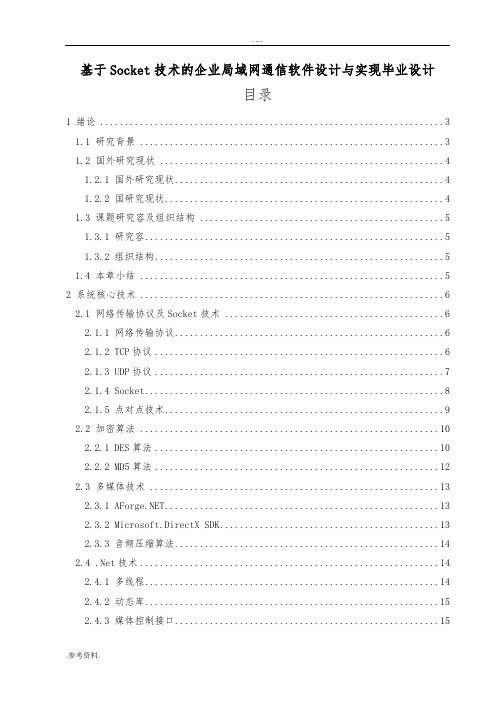
基于Socket技术的企业局域网通信软件设计与实现毕业设计目录1 绪论 (3)1.1 研究背景 (3)1.2 国外研究现状 (4)1.2.1 国外研究现状 (4)1.2.2 国研究现状 (4)1.3 课题研究容及组织结构 (5)1.3.1 研究容 (5)1.3.2 组织结构 (5)1.4 本章小结 (5)2 系统核心技术 (6)2.1 网络传输协议及Socket技术 (6)2.1.1 网络传输协议 (6)2.1.2 TCP协议 (6)2.1.3 UDP协议 (7)2.1.4 Socket (8)2.1.5 点对点技术 (9)2.2 加密算法 (10)2.2.1 DES算法 (10)2.2.2 MD5算法 (12)2.3 多媒体技术 (13)2.3.1 (13)2.3.2 Microsoft.DirectX SDK (13)2.3.3 音频压缩算法 (14)2.4 .Net技术 (14)2.4.1 多线程 (14)2.4.2 动态库 (15)2.4.3 媒体控制接口 (15)2.4.4 图形设备接口 (15)2.4.5 正则表达式 (16)2.5 三层架构技术 (16)2.6 本章小结 (17)3 系统需求分析 (18)3.1 系统概述 (18)3.2 系统业务分析 (18)3.3 客户端需求 (20)3.3.1 客户端主面板 (20)3.3.2 用户私聊 (20)3.3.3 群组聊天 (21)3.3.4 视频会议 (21)3.4 服务器需求 (21)3.4.1 服务器主界面 (22)3.4.2 员工信息管理 (22)3.4.3 历史聊天记录管理 (22)3.4.4 群共享管理 (22)3.4.5 聊天记录数据图查看 (22)3.5 非功能需求 (22)3.5.1 可靠性 (23)3.5.2 友好性 (23)3.6 本章小结 (23)4 系统设计 (24)4.1 系统整体架构 (24)4.2 客户端 (25)4.2.1 聊天模块 (25)4.2.2 群组聊天模块 (27)4.2.3 视频会议模块 (28)4.3 服务器端 (28)4.3.1 数据快速查看模块 (28)4.3.2 员工信息管理模块 (30)4.3.3 历史聊天记录管理管理模块 (30)4.3.4 群共享管理模块 (31)4.3.5 聊天记录数据图查看模块 (32)4.4 数据库设计 (33)4.5 开发环境 (37)4.6 本章小结 (37)5 系统实现 (38)5.1 用户登录模块实现 (38)5.2 个人聊天模块实现 (40)5.2.1 基本聊天功能 (40)5.2.2 文件传输功能 (42)5.2.3 屏幕截图功能 (43)5.2.4 语音聊天功能 (44)5.2.5 视频对话功能 (46)5.2.6 聊天记录功能 (48)5.2.7 快速回复容 (49)5.3 群组聊天模块实现 (50)5.3.1 群组聊天功能 (50)5.3.2 视频会议功能 (53)5.4 服务器端管理模块实现 (55)5.4.1 员工信息管理 (55)5.4.2 通信数据监控 (60)5.4.3 历史聊天数据管理 (65)5.4.4 群共享数据管理 (71)5.4.5 统计报表中心 (71)5.5 系统测试与评价 (77)5.5.1 测试环境 (77)5.5.2 数据传输测试 (78)5.5.3 模拟场景测试 (79)5.5.4 整体功能测试结果与评价 (80)5.6 本章小结 (81)总结 (82)致谢 (84)参考文献 (85)插图索引图2-1 TCP框架图 (7)图2-2 UDP框架图 (8)图2-3 Socket工作流程图 (9)图2-4 DES算法流程图 (11)图2-5 MD5算法流程图 (12)图2-6三层架构技术结构图 (17)图3-1普通用户操作流程图 (19)图3-2管理员操作流程图 (19)图4-1系统整体架构图 (24)图4-2系统功能结构图 (25)图4-3聊天功能顺序图 (25)图4-4聊天模块功能结构图 (26)图4-5文件传输流程图 (26)图4-6群组聊天功能结构图 (27)图4-7语音视频通信顺序图 (28)图4-8数据快速查看顺序图 (29)图4-9员工信息管理功能结构图 (30)图4-10历史聊天记录管理流程 (31)图4-11群共享管理流程 (32)图4-12聊天记录数据查看流程 (33)图4-13实体数据关系图 (34)图5-1 客户端登录界面 (38)图5-2 客户端主面板界面 (39)图5-3 私聊功能界面 (41)图5-4 文件发送功能界面 (42)图5-5 屏幕截图功能界面 (44)图5-6 视频聊天功能界面 (47)图5-7 历史聊天记录界面(聊天记录导入前) (48)图5-8 历史聊天记录界面(聊天记录导入后) (48)图5-9 快速回复容功能界面 (47)图1-10 群组聊天功能界面 (49)图1-11 群共享功能界面 (50)图5-12 视频会议功能界面 (53)图5-13 视频会议功能界面 (54)图5-14 服务器端管理主界面 (55)图5-15 员工信息管理界面 (56)图5-16 员工信息导出到Excel (56)图5-17 要导入的Excel文档容 (58)图5-18 员工信息从Excel导入到服务器端 (58)图1-19 实时数据监控功能界面 (58)图5-20 今日聊天记录功能界面 (64)图1-21 在线情况统计功能界面 (63)图5-22 文件传输记录查看功能界面 (65)图5-23 历史聊天记录管理界面 (66)图5-24 历史聊天记录加密状态 (68)图5-25 历史聊天记录解密状态 (68)图5-26 群共享管理界面 (71)图5-27 聊天记录数据图 (72)图5-28 聊天数据记录统计饼图显示 (72)图1-29 聊天数据记录统计柱形图显示 (73)图5-30 测试机1配置 (78)图5-31 测试机2配置 (76)附表索引表4-1 管理员信息表 (34)表4-2 今日聊天记录表 (34)表4-3 历史聊天记录表 (35)表4-4 群共享文件信息表 (35)表4-5 群组信息表 (35)表4-6 视频会议人员 (36)表4-7 文件传输记录 (36)表4-8 用户信息表 (36)表4-9 在线情况 (37)表5-1 数据传输测试结果表 (79)表5-2 部门间移动时间表 (79)表5-3 系统使用效果比对表 (80)表5-4 功能模块测试结果表 (80)基于Socket技术的企业局域网通信软件设计与实现摘要本课题围绕企业局域网通信软件展开,结合市场的实际情况,设计并实现一个基于C#.NET和Socket技术的企业局域网通信软件。
基于SOCKET的即时通信系统设计与实现教材
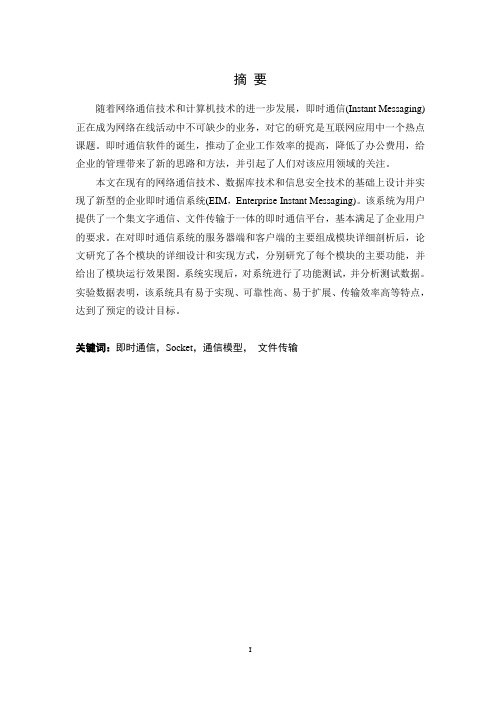
摘要随着网络通信技术和计算机技术的进一步发展,即时通信(Instant Messaging)正在成为网络在线活动中不可缺少的业务,对它的研究是互联网应用中一个热点课题。
即时通信软件的诞生,推动了企业工作效率的提高,降低了办公费用,给企业的管理带来了新的思路和方法,并引起了人们对该应用领域的关注。
本文在现有的网络通信技术、数据库技术和信息安全技术的基础上设计并实现了新型的企业即时通信系统(EIM,Enterprise Instant Messaging)。
该系统为用户提供了一个集文字通信、文件传输于一体的即时通信平台,基本满足了企业用户的要求。
在对即时通信系统的服务器端和客户端的主要组成模块详细剖析后,论文研究了各个模块的详细设计和实现方式,分别研究了每个模块的主要功能,并给出了模块运行效果图。
系统实现后,对系统进行了功能测试,并分析测试数据。
实验数据表明,该系统具有易于实现、可靠性高、易于扩展、传输效率高等特点,达到了预定的设计目标。
关键词:即时通信,Socket,通信模型,文件传输AbstractWith the network communication technology and the further development of computer technology, instant messaging (Instant Messaging) is becoming an indispensable network of online business activities; its research is a hot topic in Internet applications. The birth of instant messaging software, to promote the work efficiency of the enterprise, reducing business costs, to the enterprise's management has brought new ideas and methods, and aroused the concern of the applications.The subject in the existing network communication technology, database technology and information security technology based on the design and implementation of a new type of enterprise instant messaging system (EIM, Enterprise Instant Messaging). The system provides users with a set of text communication file transfer, instant messaging platforms in one, basically meet the requirements of business users.Then, the paper of the instant messaging system server and client modules of the main components of a detailed analysis, discusses the detailed design of each module and implementation, respectively, described the main function of each module, and gives the module flow chart. Finally, the paper of the instant messaging system designed for server-side performance test, and test data were analyzed. Experimental data show that the system has easy to implement, reliable, scalable, and high transmission efficiency, achieved its design goals.Keywords: Instant Messaging, Socket, Communication Model, File Transfer目录1 绪论 (1)1.1课题背景 (1)1.2研究现状 (1)1.3研究意义 (2)1.4研究内容 (3)1.5论文结构 (3)1.6本章小结 (4)2 SOCKET相关技术研究 (5)2.1主流即时通信模型 (5)2.1.1 P2P模型 (5)2.1.2 C/S模型 (6)2.2即时通信主流的通信协议 (7)2.2.1 UDP协议 (7)2.2.2 TCP协议 (8)2.3S OCKET技术 (8)2.4多线程技术 (9)2.5JDBC技术 (10)2.6开发工具介绍 (11)2.6.1 Eclipse简介 (11)2.6.2 MySQL简介 (12)2.6.3 Visio简介 (13)2.7本章小结 (13)3 对SOCKET通信需求分析 (14)3.1即时通信系统总体需求 (14)3.2系统功能描述 (14)3.3系统协议的选定 (14)3.4系统设计性能分析 (15)3.5本章小结 (15)4实现SOCKET通信的方案和关键模块的设计 (16)4.1系统总体结构的描述 (16)4.1.1系统功能模块设计 (17)4.2服务器端工作流程 (19)4.2.1客户端工作流程 (21)4.3总体实现方案和类的设计 (22)4.4关键模块详细设计与实现 (23)4.4.1 利用Socket进行TCP连接 (23)4.4.2面向连接的Socket机制的模块设计 (27)4.5 文件传输模块 (28)4.6本章小结 (29)5 对程序进行调试与测试,并对结果进行分析 (30)5.1S OCKET通信的应用 (30)5.2聊天服务器端 (30)5.3聊天客户端 (32)5.4聊天系统的运行界面 (33)结论 (34)具体工作如下 (34)参考文献 (35)致谢 (37)附录A英语原文 (38)附录B汉语翻译 (53)1绪论即时通信(Instant Messaging)软件是我国目前上网用户使用率最高的软件之一,即时通信系统(Instant Messagin g System)可使人们在网上识别在线用户并与之实时交流。
基于C-S模式的局域网络聊天软件系统的设计与实现

基于C-S模式的局域网络聊天软件系统的设计与实现基于C/S模式的局域网络聊天软件系统的设计与实现一、引言随着信息技术的迅速发展和网络的普及应用,互联网已经成为人们日常生活中不可或缺的一部分。
人们利用互联网进行即时通信已经变得非常普遍。
而在企业、学校等办公场所内,局域网络的存在也成为了员工、学生之间交流的主要方式。
因此,设计一款基于C/S模式的局域网络聊天软件系统,对于提高沟通效率、方便人们的日常工作学习具有重要意义。
二、系统需求分析1. 功能需求(1) 用户登录/注册:用户可以通过输入用户名和密码进行登录,如果没有账号,可以进行注册。
(2) 好友管理:用户可以添加好友、删除好友,查看好友列表。
(3) 单聊功能:用户可以与好友进行单聊,发送文字、表情、图片等消息,并且能够查看聊天记录。
(4) 群聊功能:用户可以创建群组、加入群组,发送消息与群组成员进行群聊,并且能够查看群聊记录。
(5) 在线状态管理:用户可以设置自己的在线状态,如在线、离线、忙碌等。
(6) 文件传输:用户可以发送文件给好友或群组成员,也可以接收文件。
(7) 消息提醒:用户可以接收到好友或群组成员发送的消息提醒。
2. 性能需求(1) 系统的响应速度应快,用户发送消息后能够快速接收到对方的回复。
(2) 系统的安全性要求高,确保用户信息和聊天内容不会被泄露。
(3) 系统稳定性要求高,能够长时间运行,确保用户能够随时进行聊天。
三、系统设计与实现1. 系统架构设计本系统采用C/S(Client/Server)架构,将客户端和服务器分开,提高系统的可拓展性和运行效率。
客户端主要负责与用户的交互,服务器主要负责处理客户端的请求,转发消息。
2. 服务器端设计与实现(1) 服务器端采用多线程的方式实现,能够同时处理多个客户端的请求。
每当有新的客户端连接时,服务器会创建一个新的线程与该客户端进行通信。
(2) 服务器实现登录/注册功能:当用户登录时,服务器会验证用户名和密码是否正确;当用户注册时,服务器会保存用户的信息。
毕业设计 外文资料 基于socket的网络编程

Programming Overlay Networks with Overlay SocketsThe emergence of application-layer overlay networks has inspired the development of new network services and applications. Research on overlay net-works has focused on the design of protocols to maintain and forward data in an overlay network, however, less attention has been given to the software development process of building application programs in such an environment. Clearly, the complexity of overlay network protocols calls for suitable application programming interfaces (API) and abstractions that do not require detailed knowledge of the overlay protocol, and, thereby, simplify the task of the application programmer. In this paper, we present the concept of an overlay socket as a new programming abstraction that serves as the end point of communication in an overlay network. The overlay socket provides a socket-based API that is independent of the chosen overlay topology, and can be configured to work for different overlay topologies. The overlay socket can support application data transfer over TCP, UDP, or other transport protocols. This paper describes the design of the overlay socket and discusses API and configuration options.1 IntroductionApplication-layer overlay networks provide flexible platforms for developing new network services without requiring changes to the network-layer infrastructure. Members of an overlay network, which can be hosts, routers, servers, or applications, organize themselves to form a logical network topology, and communicate only with their respective neighbors in the overlay topology. A member of an overlay network sends and receives application data, and also forwards data intended for other members. This paper addresses application development in overlay networks. We use the term overlay network programming to refer to the software development process of building application programs that communicate with one another in an application-layer overlay. This work is supported in part by the National Science Foundation through grant ANI-0085955 network. The diversity and complexity of building and maintaining overlay networks make it impractical to assume that application developers can be concerned with the complexity of managing the participation of an application in a specific overlay network topology.We present a software module, called overlay socket that intends to simplify the taskof overlay network programming. The design of the overlay socket pursues the following set of objectives: First, the application programming interface (API) of the overlay socket does not require that an application programmer has knowledge of the overlay network topology. Second, the overlay socket is designed to accommodate different overlay network topologies. Switching to different overlay network topologies is done by modifying parameters in a configuration file. Third, the overlay socket, which operates at the application layer, can accommodate different types of transport layer protocols. This is accomplished by using network adapters that interface to the un-delaying transport layer network and perform encapsulation and de-encapsulation of messages exchanged by the overlay socket. Currently available network adapters are TCP, UDP, and UDP multicast. Fourth, the overlay socket provides mechanisms for bootstrapping new overlay networks. In this paper, we provide an overview of the overlay socket design and discuss over-lay network programming with the overlay socket. The overlay socket has been implemented in Java as part of the Hyper Cast 2.0 software distribution. The software has been used for various overlay applications, and has been tested in both local-area as well as wide-area settings. The Hyper Cast 2.0 software implements the overlay topologies described in and this paper highlights important issues of the overlay socket, additional information can be found in the design documentation available from several studies before us have addressed overlay network programming issues. Even early overlay network proposals, such as Yoid, Scribe, and Scattercast, have presented APIs that aspire to achieve independence of the API from the overlay network topology used. Particularly, Yoid and Scattercast use a socket-like API, how-ever, these APIs do not address issues that arise when the same API is used by different overlay network topologies. Several works on application-layer multicast overlays integrate the application program with the software responsible for maintaining the overlay network, without explicitly providing general-purpose APIs. These include Narada, Overcast, ALMI, and NICE. A recent study has proposed a common API for the class of so-called structured overlays, which includes Chord, CAN, and Bayeux, and other overlays that were originally motivated by distributed hash tables. Our work has a different emphasis than since we assume a scenario where an application programmer must work with several, possibly fundamentally different, overlay network topologies and different transmission modes (UDP, TCP), and, therefore, needs mechanisms that make it easy to change theconfiguration of the un-delaying overlay network.Fig. 1. The overlay network is a collection of overlay sockets. Root (sender) Root (receiver) (a) Multicast (b) Unicast.Fig. 2. Data forwarding in overlay networks.The rest of the paper is organized as following. In Section 2 we introduce concepts, abstractions, and terminology needed for the discussion of the overlay socket. In Section 3 we present the design of the overlay socket, and discuss its components. In Section 4 we show how to write programs using the overlay socket. We present brief conclusions in Section 5.2 Basic ConceptsAn overlay socket is an endpoint for communication in an overlay network, and an overlay network is seen as a collection of overlay sockets that self-organize using an overlay protocol (see Figure 1). An overlay socket offers to an application programmer a Berkeley socket-style API for sending and receiving data over an overlay network. Each overlay socket executes an overlay protocol that is responsible for maintaining the membership of the socket in the overlay network topology. Each overlay socket has a logical address and a physical address in the overlay network. The logical address is dependent on the type of overlay protocol used. In the overlay protocols currently implemented in Hyper Cast 2.0, the logical addresses are 32- bit integers or _ x _ y _coordinates, where x and y are positive 32-bit positive integers. The physical address is a transport layer address where overlay sockets receive messages from the overlay network. On the Internet, the physical address is an IP address and a TCP or UDP port number. Application programs that use overlay sockets only work with logical addresses, and do not see physical addresses of overlay nodes. When an overlay socket is created, the socket is configured with a set of configuration parameters, called attributes. The application program can obtain the attributes from a configuration file or it downloads the attributes from a server. The configuration file specifies the type of overlay protocol and the type of transport protocol to be used, but also more detailed information such as the size of internal buffers, and the value of protocol-specific timers. The most important attribute is the overlay identifier (overlay ID) which is used as a global identifier for an overlay network and which can be used as a key to access the other attributes of the overlay network. Each new overlay ID corresponds to the creation of a new overlay network.Overlay sockets exchange two types of messages, protocol messages and application messages. Protocol messages are the messages of the overlay protocol that maintain the overlay topology. Application messages contain application data that is encapsulated an overlay message header. An application message uses logical addresses in the header to identify source and, for unicast, the destination of the message. If an overlay socket receives an application message from one of its neighbors in the over-lay network, it determines if the message must be forwarded to other overlay sockets, and if the message needs to be passed to the local application. The transmission modes currently supported by the overlay sockets are unicast, and multicast. In multicast, all members in the overlay network are receivers. In both unicast and multicast, the common abstraction for data forwarding is that of passing data in spanning trees that are embedded in the overlay topology. For example, a multicast message is transmitted downstream a spanning tree that has the sender of the multicast message as the root (see Figure 2(a)). When an overlay socket receives a multicast message, it forwards the message to all of its downstream neighbors (children) in the tree, and passes the message to the local application program. A unicast message is transmitted upstream a tree with the receiver of the message as the root (see Figure 2(b)). An overlay socket that receives a unicast message forwards the message to the upstream neighbor (parent) in the tree that has the destination as the root. An overlay socket makes forwarding decisions locally using only the logical ad-dresses of its neighbors and the logical address of the root of the tree. Hence, there is a requirement that each overlay socket can locally compute its parent and its children in a tree with respect to a root node. This requirement is satisfied by many overlay network topologies.3 The Components of an Overlay SocketAn overlay socket consists of a collection of components that are configured when the overlay socket is created, using the supplied set of attributes. These components include the overlay protocol, which helps to build and maintain the overlay network topology, a component that processes application data, and interfaces to a transport-layer network. The main components of an overlay socket, as illustrated in Figure 3, are as follows:The overlay node implements an overlay protocol that establishes and maintains the overlay network topology. The overlay node sends and receives overlay protocolmessages, and maintains a set of timers. The overlay node is the only component of an overlay socket that is aware of the overlay topology. In the Hyper Cast 2.0. Overlay socketForwarding EngineApplication Programming InterfaceStatistics InterfaceProtocol MessagesApplicationReceiveBufferApplicationTransmitBuffer Overlay NodeOverlay NodeInterfaceNode AdapterAdapter InterfaceSocket AdapterAdapter InterfaceApplication MessagesApplication ProgramTransport-layer NetworkApplication MessagesFig. 3. Components of an overlay socket software, there are overlay nodes that build a logical hypercube and a logical Delaunay triangulation.The forwarding engine performs the functions of an application-layer router that sends, receives, and forwards formatted application-layer messages in the overlay network. The forwarding engine communicates with the overlay node to query next hop routing information for application messages. The forwarding decision is made using logical addresses of the overlay nodes. Each overlay socket has two network adapters that each provides an interface to transport-layer protocols, such as TCP or UDP. The node adapter serves as the interface for sending and receiving overlay protocol messages, andthe socket adapter serves as the interface for application messages. Each adapter has a transport level address, which, in the case of the Internet, consists of an IP address and a UDP or TCP port number. Currently, there are three different types of adapters, for TCP, UDP, and UDP multicast. Using two adapters completely separates the handling of messages for maintaining the overlay protocol and the messages that transport application data.The application receive buffer and application transmit buffer can temporarily store messages that, respectively, have been received by the socket but not been delivered to the application, or that have been released by the application program, but not been transmitted by the socket. The application transmit buffer can play a role when messages cannot be transmitted due to rate control or congestion control constraints. The application transmit buffer is not implemented in the Hyper Cast 2.0 software. Each overlay socket has two external interfaces. The application programming interface (API) of the socket offers application programs the ability to join and leave existing overlays, to send data to other members of the overlay network, and receive data from the overlay network. The statistics interface of the overlay socket provides access to status information of components of the overlay socket, and is used for monitoring and management of an overlay socket. Note in Figure 3 that some components of the overlay socket also have interfaces, which are accessed by other components of the overlay socket. The overlay manager is a component external to the overlay socket (and not shown in Figure 3). It is responsible for configuring an overlay socket when the socket is created. The overlay manager reads a configuration file that stores the attributes of an overlay socket, and, if it is specified in the configuration file, may access attributes from a server, and then initiates the instantiation of a new overlay socket.4 Overlay Network ProgrammingAn application developer does not need to be familiar with the details of the components of an overlay socket as described in the previous section. The developer is exposed only to the API of the overlay socket and to a file with configuration parameters. The configuration file is a text file which stores all attributes needed to configure an overlay socket. The configuration file is modified whenever a change is needed to the transport protocol, the overlay protocol, or some other parameters of the overlay socket. In the following, we summarize only the main features of the API, and we refer to fordetailed information on the overlay socket API.4.1 Overlay Socket APISince the overlay topology and the forwarding of application-layer data is transparent to the application program, the API for overlay network programming can be made simple. Applications need to be able to create a new overlay network, join and leave an existing overlay network, send data to and receive data from other members in the overlay.The API of the overlay socket is message-based, and intentionally stays close to the familiar Berkeley socket API. Since space considerations do not permit a description of the full API, we sketch the API with the help of a simplified example. Figure 4 shows the fragment of a Java program that uses an overlay socket. An application program configures and creates an overlay socket with the help of an overlay manager. The overlay manager reads configuration parameters for the overlay socket from a configuration file (hyper cast prop), which can look similarly as shown in Figure 5. The application program reads the overlay ID with command on get Default Property(“OverlayID”) from the file, and creates an configuration object (config) for an overlay socket with the.// generate the configuration objectOverlayManager om = newOverlayManager("hypercast.prop");String MyOverlay = om.getDefaultProperty("OverlayID");OverlaySocketConfig config = new om.getOverlaySocketConfig(MyOverlay);// create an overlay socketOL Socket socket = config.createOverlaySocket(callback);// Join an overlaysocket.joinGroup();// Create a messageOL Message msg = socket.createMessage(byte[] data, int length);// Send the message to all members in overlay networksocket.sendToAll(msg);// Receive a message from the socketOL Message msg = socket.receive();Fig. 4. Program with overlay sockets.# OVERLAY Server:OverlayServer =# OVERLAY ID:OverlayID = 1234KeyAttributes= Socket,Node,SocketAdapter# SOCKET:Socket = HCast2-0HCAST2-0.TTL = 255HCAST2-0.ReceiveBufferSize = 200# SOCKET ADAPTER:SocketAdapter = TCPSocketAdapter.TCP.MaximumPacketLength = 16384# NODE:Node = DT2-0DT2-0.SleepTime = 400# NODE ADAPTER:NodeAdapter = NodeAdptUDPServerNodeAdapter.UDP.MaximumPacketLength = 8192NodeAdapter.UDPServer.UdpServer0 =128.143.71.50:8081Fig. 5. Configuration file (simplified) given overlay ID. The configuration object also loads all configuration information from the configuration file, and then creates the overlay socket (config create Overlay Socket).Once the overlay socket is created, the socket joins the overlay network (socket join Group). When a socket wants to multicast a message, it instantiates a new message (socket create Message) and transmits the message using the send to all method. Other transmission options are send-To-Parent, send-To-Children, sendToNeighbors, and sendToNode, which, respectively, send a message to the upstream neighbor with respect to a given root (see Figure 2), to the downstream neighbors, to all neighbors, or to a particular node with a given logical address.4.2 Overlay Network Properties ManagementAs seen, the properties of an overlay socket are configured by setting attributes in a configuration file. The overlay manager in an application process uses the attributes to create a new overlay socket. By modifying the attributes in the configuration file, an application programmer can configure the overlay protocol or transport protocol that is used by the overlay socket. Changes to the file must be done before the socket is created. Figure 5 shows a (simplified) example of a configuration file. Each line of the configuration file assigns a value to an attribute. The complete list of attributes and the range of values is documented. Without explaining all entries in Figure 5, the file sets, among others, the overlay ID to …1234 ‟, selects version 2.0 of the DT protocol as overlay protocol (…Node=DT2-0 ‟), and it sets the transport protocol of the socket adaptor to TCP(…Socket Adapter=TCP ‟).Each overlay network is associated with a set of attributes that characterize the properties of the overlay sockets that participate in the overlay network. As mentioned earlier, the most important attribute is the overlay ID, which is used to identify an y network, and which can be used as a key to access all other attributes of an overlay network. The overlay ID should be a globally unique identifier.A new overlay network is created by generating a new overlay ID and associating a set of attributes that specify the properties of the overlay sockets in the overlay network. To join an overlay network, an overlay socket must know the overlay ID and the set of attributes for this overlay ID. This information can be obtained from a configuration file, as shown in Figure 5.All attributes have a name and a value, both of which are strings. For example, the overlay protocol of an overlay socket can be determined by an attribute with name NODE. If the attribute is set to NOD-E=DT2- 0, then the overlay node in the overlay socket runs the DT (version 2) overlay protocol. The overlay socket distinguishes between two types of attributes: key attributes and configurable attributes. Key attributes are specific to an overlay network with a given overlay ID. Key attributes are selected when the overlay ID is created for an overlay network, and cannot be modified after-wards.Overlay sockets that participate in an overlay network must have identical key attributes, but can have different configurable attributes. The attributes OverlayID and Key Attributes are key attributes by default in all overlay networks. Configurable at-tributes specify parameters of an overlay socket, which are not considered essential forestablishing communication between overlay sockets in the same overlay network, and which are considered …tunable‟.5 ConclusionsWe discussed the design of an overlay socket which attempts to simplify the task of overlay network programming. The overlay socket serves as an end point of communication in the overlay network. The overlay socket can be used for various overlay topologies and support different transport protocols. The overlay socket supports a simple API for joining and leaving an overlay network, and for sending and receiving data to and from other sockets in the overlay network. The main advantage of the overlay socket is that it is relatively easy to change the configuration of the overlay network. An implementation of the overlay socket is distributed with the HyperCast2.0 soft-ware. The software has been extensively tested. A variety of different applications, such as distributed whiteboard and a video streaming application, have been developed with the overlay sockets.Acknowledgment. In addition to the authors of this article the contributors include Bhupinder Sethi, Tyler Beam, Burton Filstrup, Mike Nahas, Dongwen Wang, Konrad Lorincz, Jean Ablutz, Haiyong Wang, Weisheng Si, Huafeng Lu, and Guangyu Dong.基于Socket的网络编程应用层覆盖网络的出现促进了新网络服务和应用的发展。
基于Socket的局域网管理系统的设计与实现.

第 22卷第 1期佛山科学技术学院学报 (自然科学版 V o l . 22N o . 1 2004年 3月 Jou rnal of Fo shan U n iversity (N atu ral Science Editi on M ar . 2004文章编号 :100820171(2004 0120037204基于 Socket 的局域网管理系统的设计与实现朱玉玺 1, 刘亚姝 2(1. 佛山科学技术学院工学院 , 广东佛山 528000; 2. , 北京 100044摘要 :基于 Socket 技术 , 采用流式套接字及 TCP , 。
具体实现了“局域网的管理” , 在局域网上对。
关键词 :Socket ;中图分类号 :T P 393. 文献标识码 :A随着 In ternet 的快速发展 , 局域网作为一个行政区、企业、部门的内部信息传递网络 , 越来越受到重视。
但局域网内的机器数量的增加 , 对其设备的的管理则需要配备相当的人力资源 , 为了探讨“资源配备” 和“管理的效果” , 采用了Socket 设计技术、开发了一个局域网管理系统。
Socket (套接字是一种网络编程接口 , 它是对通信端点的一种抽象 , 提供了一种发送和接收数据的机制 [1]。
W in sock 技术就是微软公司对套接字编程结构的具体实现。
W in sock 支持两种套接字 , 他们是数据报套接字 (D atagram Socket 和流式套接字 (Stream Socket , 这两种套接字所传送的数据类型是不同的 , 因而其使用方法和相应的程序设计模型也是不同的。
本系统中采用的是流式套接字。
流式套接字可以将数据按顺序无重复的发送到目的地 , 采用的是 TCP 传输控制协议 [2]。
W in sock 网络编程有两种实现方法。
一种是直接采用 W in 32A P I 的一组套接字函数。
这种方法具有控制灵活的特点 , 但是不易于编程。
基于Socket技术的企业局域网通信软件设计与实现
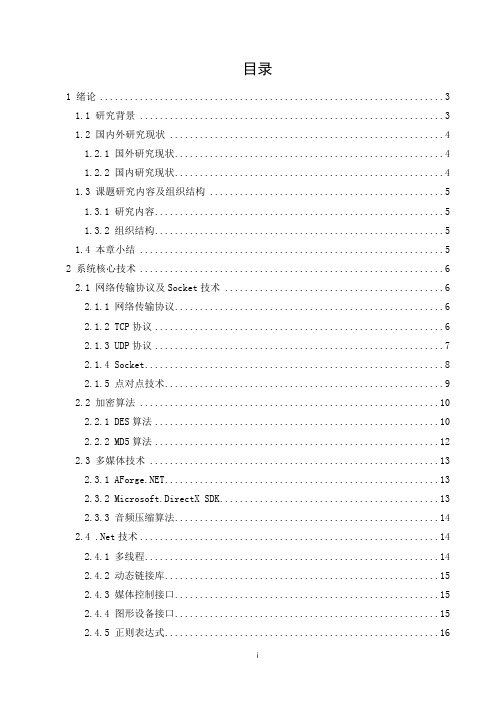
目录1 绪论 (1)1.1 研究背景 (1)1.2 国内外研究现状 (2)1.2.1 国外研究现状 (2)1.2.2 国内研究现状 (2)1.3 课题研究内容及组织结构 (3)1.3.1 研究内容 (3)1.3.2 组织结构 (3)1.4 本章小结 (3)2 系统核心技术 (4)2.1 网络传输协议及Socket技术 (4)2.1.1 网络传输协议 (4)2.1.2 TCP协议 (4)2.1.3 UDP协议 (5)2.1.4 Socket (6)2.1.5 点对点技术 (7)2.2 加密算法 (8)2.2.1 DES算法 (8)2.2.2 MD5算法 (10)2.3 多媒体技术 (11)2.3.1 (11)2.3.2 Microsoft.DirectX SDK (11)2.3.3 音频压缩算法 (12)2.4 .Net技术 (12)2.4.1 多线程 (12)2.4.2 动态链接库 (13)2.4.3 媒体控制接口 (13)2.4.4 图形设备接口 (13)2.4.5 正则表达式 (14)2.5 三层架构技术 (14)2.6 本章小结 (15)3 系统需求分析 (16)3.1 系统概述 (16)3.2 系统业务分析 (16)3.3 客户端需求 (18)3.3.1 客户端主面板 (18)3.3.2 用户私聊 (18)3.3.3 群组聊天 (19)3.3.4 视频会议 (19)3.4 服务器需求 (19)3.4.1 服务器主界面 (20)3.4.2 员工信息管理 (20)3.4.3 历史聊天记录管理 (20)3.4.4 群共享管理 (20)3.4.5 聊天记录数据图查看 (20)3.5 非功能需求 (20)3.5.1 可靠性 (21)3.5.2 友好性 (21)3.6 本章小结 (21)4 系统设计 (22)4.1 系统整体架构 (22)4.2 客户端 (23)4.2.1 聊天模块 (23)4.2.2 群组聊天模块 (25)4.2.3 视频会议模块 (26)4.3 服务器端 (26)4.3.1 数据快速查看模块 (26)4.3.2 员工信息管理模块 (28)4.3.3 历史聊天记录管理管理模块 (28)4.3.4 群共享管理模块 (29)4.3.5 聊天记录数据图查看模块 (30)4.4 数据库设计 (31)4.5 开发环境 (35)4.6 本章小结 (35)5 系统实现 (36)5.1 用户登录模块实现 (36)5.2 个人聊天模块实现 (38)5.2.1 基本聊天功能 (38)5.2.2 文件传输功能 (40)5.2.3 屏幕截图功能 (41)5.2.4 语音聊天功能 (42)5.2.5 视频对话功能 (44)5.2.6 聊天记录功能 (46)5.2.7 快速回复内容 (47)5.3 群组聊天模块实现 (48)5.3.1 群组聊天功能 (48)5.3.2 视频会议功能 (51)5.4 服务器端管理模块实现 (53)5.4.1 员工信息管理 (53)5.4.2 通信数据监控 (58)5.4.3 历史聊天数据管理 (63)5.4.4 群共享数据管理 (69)5.4.5 统计报表中心 (69)5.5 系统测试与评价 (75)5.5.1 测试环境 (75)5.5.2 数据传输测试 (76)5.5.3 模拟场景测试 (77)5.5.4 整体功能测试结果与评价 (78)5.6 本章小结 (79)总结 (80)致谢 (82)参考文献 (83)插图索引图2-1 TCP框架图 (5)图2-2 UDP框架图 (6)图2-3 Socket工作流程图 (7)图2-4 DES算法流程图 (9)图2-5 MD5算法流程图 (10)图2-6三层架构技术结构图 (15)图3-1普通用户操作流程图 (17)图3-2管理员操作流程图 (17)图4-1系统整体架构图 (22)图4-2系统功能结构图 (23)图4-3聊天功能顺序图 (23)图4-4聊天模块功能结构图 (24)图4-5文件传输流程图 (24)图4-6群组聊天功能结构图 (25)图4-7语音视频通信顺序图 (26)图4-8数据快速查看顺序图 (27)图4-9员工信息管理功能结构图 (28)图4-10历史聊天记录管理流程 (29)图4-11群共享管理流程 (30)图4-12聊天记录数据查看流程 (31)图4-13实体数据关系图 (32)图5-1 客户端登录界面 (36)图5-2 客户端主面板界面 (37)图5-3 私聊功能界面 (39)图5-4 文件发送功能界面 (40)图5-5 屏幕截图功能界面 (42)图5-6 视频聊天功能界面 (45)图5-7 历史聊天记录界面(聊天记录导入前) (46)图5-8 历史聊天记录界面(聊天记录导入后) (46)图5-9 快速回复内容功能界面 (47)图1-10 群组聊天功能界面 (49)图1-11 群共享功能界面 (50)图5-12 视频会议功能界面 (51)图5-13 视频会议功能界面 (52)图5-14 服务器端管理主界面 (53)图5-15 员工信息管理界面 (54)图5-16 员工信息导出到Excel (54)图5-17 要导入的Excel文档内容 (56)图5-18 员工信息从Excel导入到服务器端 (56)图1-19 实时数据监控功能界面 (58)图5-20 今日聊天记录功能界面 (62)图1-21 在线情况统计功能界面 (63)图5-22 文件传输记录查看功能界面 (63)图5-23 历史聊天记录管理界面 (64)图5-24 历史聊天记录加密状态 (66)图5-25 历史聊天记录解密状态 (66)图5-26 群共享管理界面 (69)图5-27 聊天记录数据图 (70)图5-28 聊天数据记录统计饼图显示 (70)图1-29 聊天数据记录统计柱形图显示 (73)图5-30 测试机1配置 (76)图5-31 测试机2配置 (76)附表索引表4-1 管理员信息表 (32)表4-2 今日聊天记录表 (32)表4-3 历史聊天记录表 (33)表4-4 群共享文件信息表 (33)表4-5 群组信息表 (33)表4-6 视频会议人员 (34)表4-7 文件传输记录 (34)表4-8 用户信息表 (34)表4-9 在线情况 (35)表5-1 数据传输测试结果表 (77)表5-2 部门间移动时间表 (77)表5-3 系统使用效果比对表 (78)表5-4 功能模块测试结果表 (78)基于Socket技术的企业局域网通信软件设计与实现摘要本课题围绕企业局域网通信软件展开,结合市场的实际情况,设计并实现一个基于C#.NET和Socket技术的企业局域网通信软件。
局域网聊天软件的设计与实现毕业论文

郑州轻工业学院本科毕业设计(论文)题目局域网聊天软件的_______设计与实现_____ 学生姓名****专业班级***********学号1234567890院(系)计算机与通信工程学院指导教师(职称) ***(讲师)****(副教授)完成时间2015年5月30日郑州轻工业学院毕业设计(论文)任务书题目局域网聊天软件的设计与实现专业***学号*********姓名*****主要内容、基本要求、主要参考资料等:主要内容:1。
客户端的设计和实现2. 服务器的设计和实现3。
多用户聊天及文本文件的传输基本要求: 1. 熟悉TCP通信协议以及编程、socket网络编程2。
熟悉多线程和多进程、线程同步3. 熟悉linux系统下的文件传输主要参考资料:[1]何波玲,绥菱歌。
TCP/UDP下一种网络透明传输服务编程接口是实现方法[J]。
哈尔滨师范大学自然科学学报,2011,27(6):56-60。
[2]殷晓辉.基于linux操作系统的网络编程方法研究[J]。
科技传播,2011,4(13):210-211.[3] 张海光。
浅谈Linux操作系统下的多线程编程[J]。
华南金融脑,2006,9(3):172-184。
完成期限:2015 年5月30日指导教师签名:专业负责人签名:2015年1月12 日目录摘要 ................................................................................................................................................ ABSTRACT.. (I)1引言 01.1开发背景 01。
2 网络聊天室的现状及发展 (1)1.3 课题研究的意义 (2)2 开发平台及技术支持 (3)2。
1 开发环境 (3)2.2 系统实现技术 (3)2。
2.1网络传输层协议—TCP/IP 协议 (3)2。
基于Socket编程的网络应用软件设计
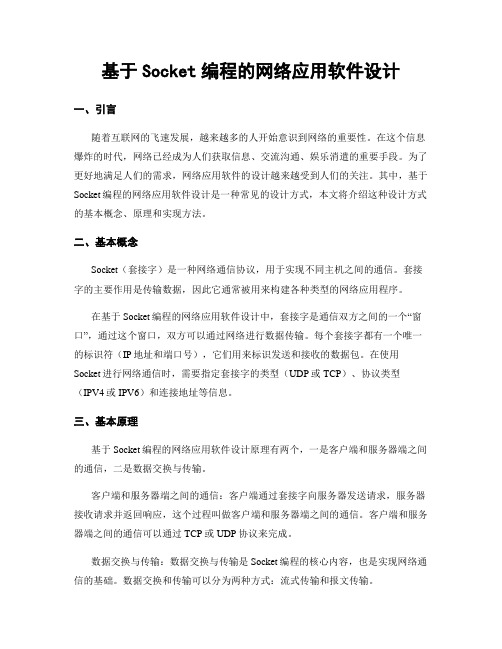
基于Socket编程的网络应用软件设计一、引言随着互联网的飞速发展,越来越多的人开始意识到网络的重要性。
在这个信息爆炸的时代,网络已经成为人们获取信息、交流沟通、娱乐消遣的重要手段。
为了更好地满足人们的需求,网络应用软件的设计越来越受到人们的关注。
其中,基于Socket编程的网络应用软件设计是一种常见的设计方式,本文将介绍这种设计方式的基本概念、原理和实现方法。
二、基本概念Socket(套接字)是一种网络通信协议,用于实现不同主机之间的通信。
套接字的主要作用是传输数据,因此它通常被用来构建各种类型的网络应用程序。
在基于Socket编程的网络应用软件设计中,套接字是通信双方之间的一个“窗口”,通过这个窗口,双方可以通过网络进行数据传输。
每个套接字都有一个唯一的标识符(IP地址和端口号),它们用来标识发送和接收的数据包。
在使用Socket进行网络通信时,需要指定套接字的类型(UDP或TCP)、协议类型(IPV4或IPV6)和连接地址等信息。
三、基本原理基于Socket编程的网络应用软件设计原理有两个,一是客户端和服务器端之间的通信,二是数据交换与传输。
客户端和服务器端之间的通信:客户端通过套接字向服务器发送请求,服务器接收请求并返回响应,这个过程叫做客户端和服务器端之间的通信。
客户端和服务器端之间的通信可以通过TCP或UDP协议来完成。
数据交换与传输:数据交换与传输是Socket编程的核心内容,也是实现网络通信的基础。
数据交换和传输可以分为两种方式:流式传输和报文传输。
流式传输:使用TCP协议时,数据是以字节流的形式进行传输的。
发送方将数据按照字节的形式发送到网络中,接收方再将其按照同样的字节顺序接收。
由于TCP协议使用了可靠的连接,因此数据传输的顺序不会出现错误。
报文传输:使用UDP协议时,数据是以报文的形式进行传输的。
每个数据包都有一个独立的标识符,接收方可以根据这个标识符来解析数据包。
由于UDP协议不保证数据传输的可靠性和顺序,因此在数据传输过程中需要特别注意。
- 1、下载文档前请自行甄别文档内容的完整性,平台不提供额外的编辑、内容补充、找答案等附加服务。
- 2、"仅部分预览"的文档,不可在线预览部分如存在完整性等问题,可反馈申请退款(可完整预览的文档不适用该条件!)。
- 3、如文档侵犯您的权益,请联系客服反馈,我们会尽快为您处理(人工客服工作时间:9:00-18:30)。
基于Socket技术的企业局域网通信软件设计与实现毕业设计目录1 绪论 (3)1.1 研究背景 (3)1.2 国外研究现状 (4)1.2.1 国外研究现状 (4)1.2.2 国研究现状 (4)1.3 课题研究容及组织结构 (5)1.3.1 研究容 (5)1.3.2 组织结构 (5)1.4 本章小结 (5)2 系统核心技术 (6)2.1 网络传输协议及Socket技术 (6)2.1.1 网络传输协议 (6)2.1.2 TCP协议 (6)2.1.3 UDP协议 (7)2.1.4 Socket (8)2.1.5 点对点技术 (9)2.2 加密算法 (10)2.2.1 DES算法 (10)2.2.2 MD5算法 (12)2.3 多媒体技术 (13)2.3.1 (13)2.3.2 Microsoft.DirectX SDK (13)2.3.3 音频压缩算法 (14)2.4 .Net技术 (14)2.4.1 多线程 (14)2.4.2 动态库 (15)2.4.3 媒体控制接口 (15)2.4.4 图形设备接口 (15)2.4.5 正则表达式 (16)2.5 三层架构技术 (16)2.6 本章小结 (17)3 系统需求分析 (18)3.1 系统概述 (18)3.2 系统业务分析 (18)3.3 客户端需求 (20)3.3.1 客户端主面板 (20)3.3.2 用户私聊 (20)3.3.3 群组聊天 (21)3.3.4 视频会议 (21)3.4 服务器需求 (21)3.4.1 服务器主界面 (22)3.4.2 员工信息管理 (22)3.4.3 历史聊天记录管理 (22)3.4.4 群共享管理 (22)3.4.5 聊天记录数据图查看 (22)3.5 非功能需求 (22)3.5.1 可靠性 (23)3.5.2 友好性 (23)3.6 本章小结 (23)4 系统设计 (24)4.1 系统整体架构 (24)4.2 客户端 (25)4.2.1 聊天模块 (25)4.2.2 群组聊天模块 (27)4.2.3 视频会议模块 (28)4.3 服务器端 (28)4.3.1 数据快速查看模块 (28)4.3.2 员工信息管理模块 (30)4.3.3 历史聊天记录管理管理模块 (30)4.3.4 群共享管理模块 (31)4.3.5 聊天记录数据图查看模块 (32)4.4 数据库设计 (33)4.5 开发环境 (37)4.6 本章小结 (37)5 系统实现 (38)5.1 用户登录模块实现 (38)5.2 个人聊天模块实现 (40)5.2.1 基本聊天功能 (40)5.2.2 文件传输功能 (42)5.2.3 屏幕截图功能 (43)5.2.4 语音聊天功能 (44)5.2.5 视频对话功能 (46)5.2.6 聊天记录功能 (48)5.2.7 快速回复容 (49)5.3 群组聊天模块实现 (50)5.3.1 群组聊天功能 (50)5.3.2 视频会议功能 (53)5.4 服务器端管理模块实现 (55)5.4.1 员工信息管理 (55)5.4.2 通信数据监控 (60)5.4.3 历史聊天数据管理 (65)5.4.4 群共享数据管理 (71)5.4.5 统计报表中心 (71)5.5 系统测试与评价 (77)5.5.1 测试环境 (77)5.5.2 数据传输测试 (78)5.5.3 模拟场景测试 (79)5.5.4 整体功能测试结果与评价 (80)5.6 本章小结 (81)总结 (82)致谢 (84)参考文献 (85)插图索引图2-1 TCP框架图 (7)图2-2 UDP框架图 (8)图2-3 Socket工作流程图 (9)图2-4 DES算法流程图 (11)图2-5 MD5算法流程图 (12)图2-6三层架构技术结构图 (17)图3-1普通用户操作流程图 (19)图3-2管理员操作流程图 (19)图4-1系统整体架构图 (24)图4-2系统功能结构图 (25)图4-3聊天功能顺序图 (25)图4-4聊天模块功能结构图 (26)图4-5文件传输流程图 (26)图4-6群组聊天功能结构图 (27)图4-7语音视频通信顺序图 (28)图4-8数据快速查看顺序图 (29)图4-9员工信息管理功能结构图 (30)图4-10历史聊天记录管理流程 (31)图4-11群共享管理流程 (32)图4-12聊天记录数据查看流程 (33)图4-13实体数据关系图 (34)图5-1 客户端登录界面 (38)图5-2 客户端主面板界面 (39)图5-3 私聊功能界面 (41)图5-4 文件发送功能界面 (42)图5-5 屏幕截图功能界面 (44)图5-6 视频聊天功能界面 (47)图5-7 历史聊天记录界面(聊天记录导入前) (48)图5-8 历史聊天记录界面(聊天记录导入后) (48)图5-9 快速回复容功能界面 (47)图1-10 群组聊天功能界面 (49)图1-11 群共享功能界面 (50)图5-12 视频会议功能界面 (53)图5-13 视频会议功能界面 (54)图5-14 服务器端管理主界面 (55)图5-15 员工信息管理界面 (56)图5-16 员工信息导出到Excel (56)图5-17 要导入的Excel文档容 (58)图5-18 员工信息从Excel导入到服务器端 (58)图1-19 实时数据监控功能界面 (58)图5-20 今日聊天记录功能界面 (64)图1-21 在线情况统计功能界面 (63)图5-22 文件传输记录查看功能界面 (65)图5-23 历史聊天记录管理界面 (66)图5-24 历史聊天记录加密状态 (68)图5-25 历史聊天记录解密状态 (68)图5-26 群共享管理界面 (71)图5-27 聊天记录数据图 (72)图5-28 聊天数据记录统计饼图显示 (72)图1-29 聊天数据记录统计柱形图显示 (73)图5-30 测试机1配置 (78)图5-31 测试机2配置 (76)附表索引表4-1 管理员信息表 (34)表4-2 今日聊天记录表 (34)表4-3 历史聊天记录表 (35)表4-4 群共享文件信息表 (35)表4-5 群组信息表 (35)表4-6 视频会议人员 (36)表4-7 文件传输记录 (36)表4-8 用户信息表 (36)表4-9 在线情况 (37)表5-1 数据传输测试结果表 (79)表5-2 部门间移动时间表 (79)表5-3 系统使用效果比对表 (80)表5-4 功能模块测试结果表 (80)基于Socket技术的企业局域网通信软件设计与实现摘要本课题围绕企业局域网通信软件展开,结合市场的实际情况,设计并实现一个基于C#.NET和Socket技术的企业局域网通信软件。
本系统支持企业部局域网的即时一对一聊天,群组聊天,文件传输,视频会议等功能。
系统运行于企业部的局域网,能够有效阻止企业部信息的外泄,能为企业提供高效安全的部沟通。
本课题的研究能够为企业提供高效的信息沟通,同时能有效的保障数据传输的安全性,提高企业的工作效率,促进企业的发展。
测试结果表明,本课题实现的企业局域网通信软件运行状态良好,各个模块的测试结果都符合预期结果。
本系统能够为企业的部沟通提供一个有力的平台,提高企业OA程度,促进企业的发展和改革。
关键词:局域网通信;音视频聊天;数据加密;数据分析The Design and Implementation of Enterprise LAN Communication Software Based on SocketAbstractThis paper focuses on the LAN communication software of the enterprise. By integrating with actual conditions of the market, the paper aims to design and implement a sort of LAN communication software of the enterprise based on C#.NET and Socket technology. This system supports some functions in enterprises' internal LAN, such as one-on-one IM, group chat, file transfer and video conferences, etc. The software runs within the enterprise local area network, so as to effectively prevent enterprise internal secret information from leaking out. In this way, efficient and safe internal communication will be provided for the enterprise. The research and system implement of this topic can provide high efficient communicative information for the enterprise. At the same time, it can effectively protect the security of the data transportation and improve the working efficiency of the enterprise, thus to promote the development of the enterprise.Test results indicate that the enterprise LAN communication software implemented in this subject is in good operation status, and test result of each module is in accordance with the expected one. This system provides a powerful platform for the internal communication of the enterprise, and it can also provide an OA level of the enterprise and promote the reform and development of the enterprise.Key words:LAN communication; Audio/video chat; Data encryption; Data analysis1绪论本章主要阐述了国外研究现状,并展示了本课题所研究的主要容以及论文的整体组织结构。
